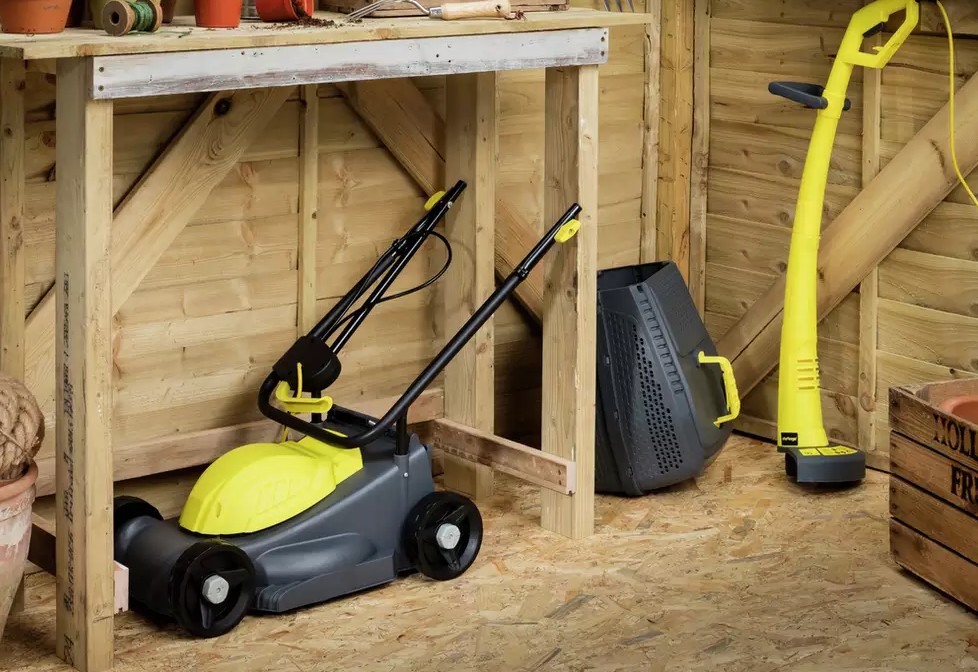
If your lawnmower is on its last legs—or you’re simply ready for an upgrade—there’s more to think about than just picking up the first one you see on our site. With a wide range of mowers available, it’s worth weighing up your options to find the right one for your garden and lifestyle. Here are the key things to consider before buying.
Power Type: Electric, Battery or Petrol
One of the first choices to make is how your lawnmower will be powered.
Manual Push Mowers
Manual mowers are a great choice for small, flat gardens. They don’t use electricity or petrol—just your own pushing power. They’re quiet, eco-friendly, and great for giving your grass a clean, scissor-like cut. On the flip side, they’re best suited for regular mowing and may struggle with long or damp grass. If you enjoy a bit of physical effort, want to lower energy bills and your lawn is compact, this no-fuss “old school” option might suit you perfectly.
Corded Electric mowers are great for small to medium gardens. They’re usually lighter, require less maintenance, and are more affordable—but the cable can get in the way and limit your reach.
Battery-powered (cordless electric) mowers offer freedom of movement and are generally quieter than petrol options. They're ideal for small to medium lawns, but battery life and charging time should be considered.
Petrol mowers are the most powerful and are best suited for larger gardens or tougher grass. They’re more robust and often come with self-propelling features to make the job easier—but they’re heavier, louder, and need more maintenance.
Size of Your Garden
Matching the mower to your lawn size is essential:
- Small lawns don’t need anything too large or powerful—something lightweight with a modest cutting width is usually enough.
- Medium gardens may benefit from a mower with a wider cutting deck and a bit more power to make the job faster and more efficient.
- Large gardens often require petrol mowers or high-capacity battery models with wider cutting widths and longer run times.
Key Features to Look For
Modern mowers come with a range of helpful features. Some of the most useful include:
- Adjustable cutting heights, so you can tailor the length of your grass to the season.
- Larger grass collection boxes, which mean fewer stops to empty clippings.
- Mulching functions, which return cut grass to the lawn as natural fertiliser.
- Self-propelled mechanisms, often found on petrol mowers, which take the strain off you when mowing larger or sloped gardens.
Storage and Maintenance
Choosing a lawnmower isn’t just about how it performs on the grass—it's also important to consider what happens when you're not using it. Proper storage and regular maintenance will help extend the life of your mower and keep it running smoothly, season after season.
Storage Considerations
Space: Think about where your mower will be stored. If you’re short on space—say, in a small shed or garage—compact electric or battery models are easier to tuck away. Some have foldable handles or vertical storage designs, which help save space.
Ventilation: For petrol mowers especially, proper ventilation is essential. Fumes and fuel vapours need space to dissipate safely, so an enclosed cupboard or utility room isn’t suitable. A well-ventilated shed or garage is ideal.
Accessibility: Make sure your mower is stored in a place that’s easy to access and move in and out of, particularly if it’s on the heavier side. Wheels should roll freely, and it shouldn’t take a wrestling match to get it out each time the grass needs a trim.
Maintenance Needs
- Blade care is key. Keep the blades clean and free from grass build-up after each use.
- Check alignment of the blades. If they get out of sync, cutting performance will drop. Many models have an adjustment mechanism to realign them. Refer to the user manual for guidance.
Electric (corded) mowers are generally the lowest maintenance:
- Clear out any built-up grass and check the cable for wear or damage. Aside from that, they’re plug-in-and-go.
Battery-powered mowers need similar basic care:
- Keeping the underside clean, sharpening the blades, and storing the battery correctly. Batteries should be kept in a cool, dry place when not in use, ideally removed from the mower and not left on charge indefinitely. Over time, the battery may need replacing depending on how often you mow.
Petrol mowers require more attention. In addition to blade maintenance and cleaning:
- Oil needs to be checked and changed periodically.
- Air filters should be cleaned or replaced to ensure the engine breathes properly.
- Petrol should be drained if the mower is being stored for winter. Leaving fuel in the tank can cause it to go stale, clog or even damage the engine.
- You may also want to give your mower a general check-over at the start of spring—tighten bolts, inspect wheels and handles, and make sure everything is in working order before the first mow of the season.
Always refer to the user manual for specific guidance and storage instructions.
Final Thoughts
Buying a new lawnmower isn’t a one-size-fits-all decision. Consider the size of your garden, how much effort you want to put in, and how much storage and maintenance you're comfortable with. Whether you want something light and easy or more heavy-duty, there’s a mower out there to suit you—and your lawn will thank you for it.
View the full range here